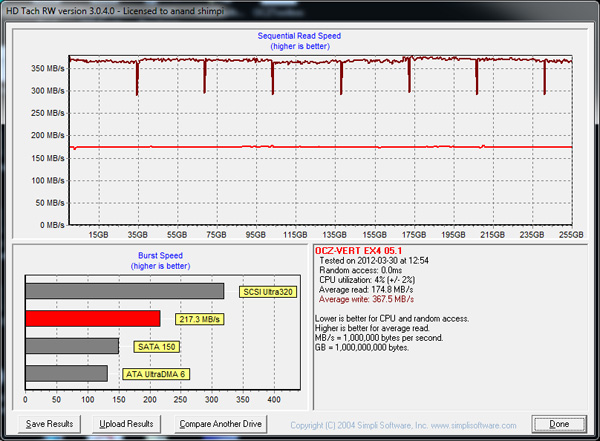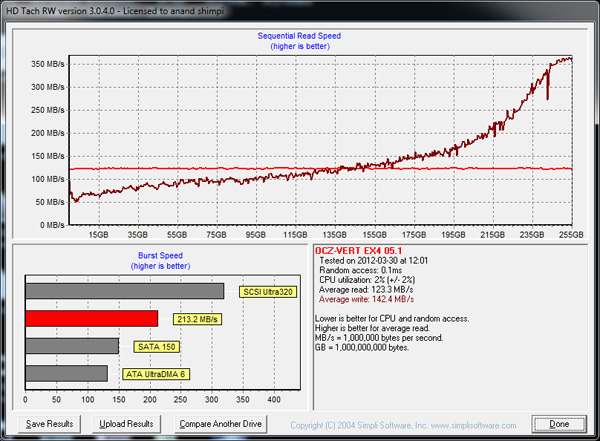OCZ Vertex 4 Review (256GB, 512GB)
by Anand Lal Shimpi on April 4, 2012 9:00 AM ESTTRIM Performance
I started out this review with a mention of estimated write amplification and how OCZ was able to significantly reduce it with the Vertex 4/Everest 2 compared to Octane/Everest 1. By reducing write amplification, OCZ should have also significantly improved worst case write performance when TRIM isn't available or before it's able to act.
To find out, I wrote sequential data across all user addressable LBAs and then wrote random data (4KB, QD=32) for 20 minutes across all LBAs. Finally I used HDTach to give me a simple visualization of write performance across all available LBAs (aka the Malventano Method):
This is a huge improvement over what we saw with the Octane. Behavior here isn't quite what we see with Intel's controllers, but again it's a huge step above what we saw in the previous generation.
The Vertex 4 does support idle time garbage collection, but at very low priority. The drive must be idle for at least an hour for the background GC to kick in. I'm glad to see that OCZ has taken a more conservative route here as I've never been a huge fan of idle time garbage collection to begin with.
If you don't leave the drive alone long enough to trigger the idle GC, as soon as 85% of the blocks on the drive are used up the Vertex 4 will automatically trigger its garbage collection algorithms. This is more of what I'd like to see, however I'd prefer it even more if OCZ lowered the limits of when it would start recycling blocks in order to try and maintain good performance under heavily fragmented conditions.
TRIM is alive and well on the drive – a single TRIM pass is able to restore performance to new:












127 Comments
View All Comments
elghosto - Wednesday, April 4, 2012 - link
linux#fstrim
Per Hansson - Wednesday, April 4, 2012 - link
"monitoring port of the SSD"Please enlighten me, Google was no help...
Is it a hardware interface that allows you to see how the drive operates?
adamantinepiggy - Thursday, April 5, 2012 - link
Basically, every SSD has some sort of real-time data port that allows engineers to monitor what is going on with the SSD, even when the drive hangs or has other issues. It is used mainly for development/testing. Consider it sorta like a way to read/access the dump file when Windows BSOD's, except in this case it's on the SSD. This monitoring port gets disabled on released drive firmware and the hardware attachment leads are unattached..jonup - Wednesday, April 4, 2012 - link
Thanks for asking this! I always wanted to know that myself. I actually google it to no avail while I was reading the article.medys - Wednesday, April 4, 2012 - link
How long till we are overclocking our SSD processors :-/FunBunny2 - Wednesday, April 4, 2012 - link
Umm. How you gonna fit that water cooler inside the case?Iketh - Wednesday, April 4, 2012 - link
hahaha... NEVER!! I've yet to break a Win7 installation from overclocking, but I broke XP many times... I shudder at the thought of overclocking an SSD :)Iketh - Wednesday, April 4, 2012 - link
Although, I wonder how long until the processors in SSDs reach, say, today's single-core Atom... OR better yet, how long before the SSD controller is built into the CPU much like the memory controller, where we install more storage the same way we install ram... and then later again the nand controller and RAM controller merge, and a computer is nothing more than a SoC with some nand sitting next to it...iwod - Wednesday, April 4, 2012 - link
We finally have controller that are able to bump out MB faster then Sandforce without using some silly compression engine. Marvell also announced next Gen SSD controller as well.Again we have reached the limit of SATA 6Gbps, we will need to start thinking about SATA Express, Lower power consumption, reliability. etc...
akbo - Wednesday, April 4, 2012 - link
Though I think the high consumption might be because of the controller, the chip is huge! With thermy sticky!Wonder when a die shrink of this is possible.